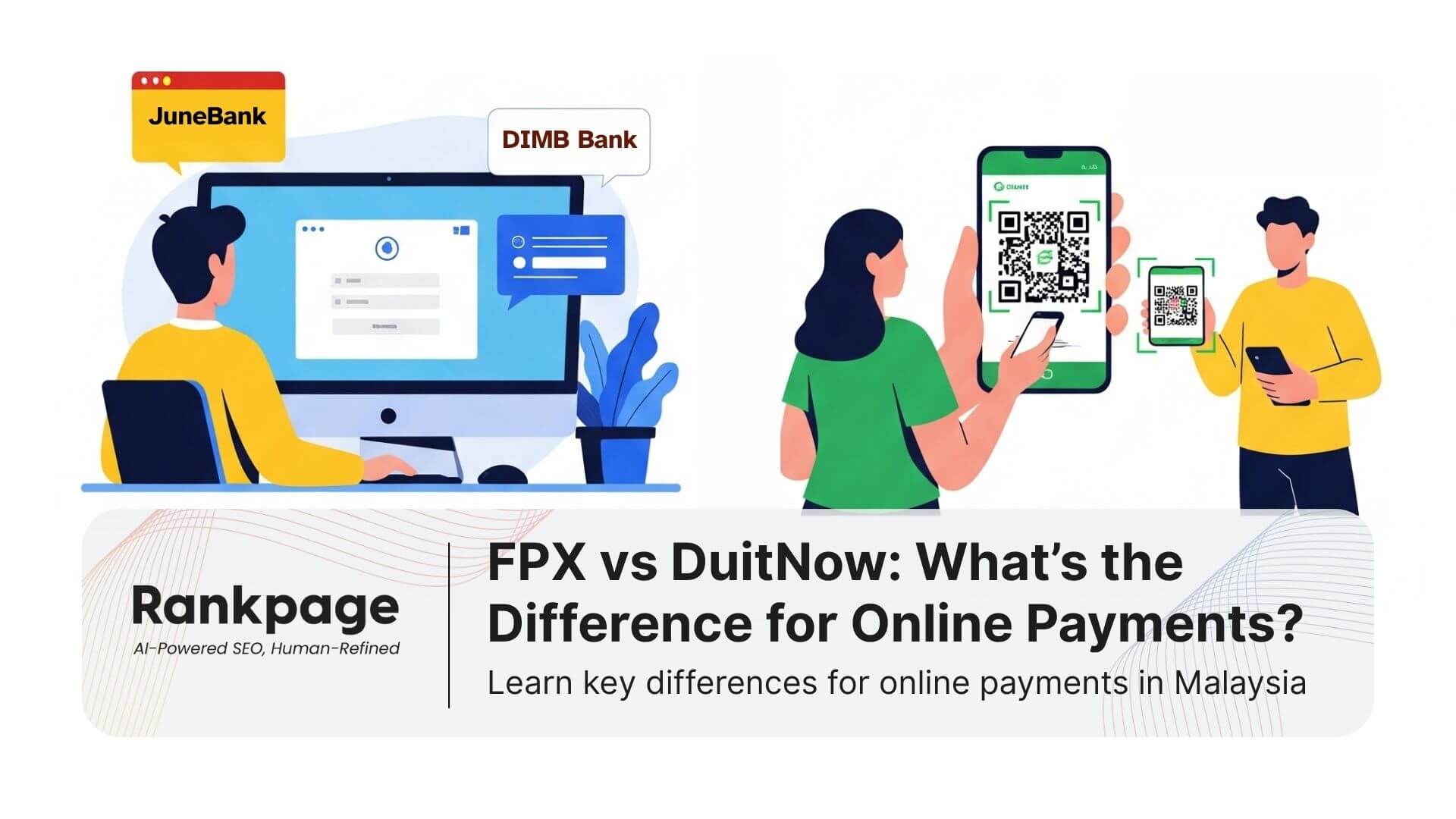Key Takeaways
- FPX requires online banking login and is ideal for e-commerce and bill payments.
- DuitNow works via QR code or mobile number and supports fast, casual peer-to-peer transfers.
- Both are secure and regulated by Bank Negara Malaysia and offer real-time payment options.
- Businesses benefit by offering both: FPX for formal payments, DuitNow for flexible QR-based transactions.
- DuitNow AutoDebit suits subscriptions, while FPX Recurring provides push-based structured authorisation.
FPX and DuitNow are both real-time online payment methods in Malaysia, but they’re built for different use cases.
If you’ve ever bought something on Shopee, paid your bills online, or scanned a QR code at a mamak stall, you’ve likely used one (or both) of them. But when it comes to choosing the right one for your business, your checkout flow, or even your daily transfers, the differences start to matter.
Today, we will break down FPX vs DuitNow. How they work, what makes them different, and which is better for various scenarios like e-commerce, SME billing, QR payments, and subscriptions. Let’s get to it.
Table of Contents
What’s the Difference Between FPX and DuitNow?
FPX and DuitNow are both secure, real-time payment options used widely in Malaysia, but they serve different needs.
While FPX connects users to online banking portals for structured, high-trust payments, DuitNow enables flexible transfers via QR or linked IDs without logging into your bank each time.
In other words: FPX is for checkout, DuitNow is for speed.
“Update: Malaysian banks are gradually transitioning checkout flows from FPX to DuitNow Online Banking/Wallets (DOBW). For users, this means you may see “DuitNow” branding instead of “FPX” at e-commerce checkout, but the experience remains the same, a secure redirect to your bank for TAC/OTP confirmation.”
FPX vs DuitNow: Comparison Table
Feature | FPX | DuitNow |
Use Case | Online shopping, bill payments, eGov portals | QR payments, peer-to-peer, microbusiness sales |
Bank Login Needed | Yes (via online banking portal + TAC) | No (uses phone/IC/Biz Reg + app or wallet) |
Transaction Speed | Real-time | Instant |
User Cost | Usually free | Free for consumers up to RM5,000 per transaction RM0.50 may apply above RM5,000 (some banks waive this) |
Security | Multi-step login + OTP/TAC | App-based PIN or biometric + QR authentication |
Best For | E-commerce, insurance, government payments | Hawker stalls, freelancers, instant transfers |
Recurring Payments | Requires user confirmation (push-based) | One-time authorisation (pull-based AutoDebit) |
What Is FPX and How Does It Work?
FPX (Financial Process Exchange) is Malaysia’s online payment gateway that allows users to pay directly from their bank accounts.
You’ll most commonly see FPX at checkout on government portals, e-commerce and billers (LHDN/IRBM, PTPTN):
- Paying bills on LHDN or PTPTN portals
- Buying on Lazada, Shopee, or travel booking sites
- Topping up e-wallets or insurance payments
Here’s how it works:
- Select FPX at checkout
- Choose your bank from the list
- Login to your internet banking
- Confirm with a TAC/OTP
- Payment completes instantly
“FPX is supported by major Malaysian banks; availability/hours vary by bank.”
How Does DuitNow Work?
DuitNow is a real-time transfer service that supports QR code scanning, mobile number-based payments, and AutoDebit.
It simplifies payments by skipping full bank login. Just use:
- DuitNow Transfer: Send money to a mobile number, IC, or company registration.
- DuitNow QR: Scan QR codes at stalls, online businesses, or fundraising events.
- DuitNow AutoDebit: One-time authorisation to pull funds regularly.
Use cases include:
- Paying for nasi lemak at a food truck
- Sending RM30 to your friend after dinner
- Donating to a charity with a scanned QR
Note: DuitNow works across major banks and most mobile wallets (TNG eWallet, Boost, GrabPay, MAE).
Which Is More Secure, FPX or DuitNow?
Both FPX and DuitNow are Bank Negara–regulated and are highly secure, but the way they protect users is different.
FPX Security (Best for High-Stakes Transactions)
Bank login + TAC offers strong multi-layer protection.
- Every FPX transaction requires you to log into your bank’s official portal, no third-party redirects.
- A TAC (Transaction Authorisation Code) or OTP must be entered to confirm the payment.
- Ideal for bill payments, insurance, or anything over RM1,000, where traceability and control are key.
Example: Paying your PTPTN loan or settling a RM2,500 insurance premium.
DuitNow Security (Fast but Depends on App Safety)
Relies on device-level security like PINs, biometrics, and QR verification.
- DuitNow Transfer and QR payments run through your mobile banking app or wallet (. MAE, TNG, Boost).
- Biometric authentication (Face ID, fingerprint) or secure PINs are used instead of bank login.
- More vulnerable to QR scams, especially in public places where fake QR codes may be placed over real ones.
Always check the merchant name or company ID before confirming a QR payment.
- Use FPX for larger, sensitive transactions.
- Use DuitNow for speed, but always double-check that QR code.
Which Is Faster: DuitNow or FPX?
DuitNow edges out FPX for instant day-to-day use, but both are real-time.
Payment Type | Speed | Best For |
DuitNow Transfer / QR | Instant / 24×7. | Casual transfers, QR merchant payments |
FPX via Online Banking | Real-time; typically instant, subject to bank availability. | Online shopping, formal bills |
DuitNow AutoDebit | Automatic pull on schedule after one-time consent (near real-time; bank cycles apply) | Subscriptions, recurring donations |
FPX Recurring | Scheduled (with TAC) | Utility bills, insurance renewals |
Can I Use Both FPX and DuitNow?
Most Malaysians already do! There’s no need to choose. You can mix and match depending on your payment situation:
- FPX when paying your electricity bill or shopping at Lazada/Shopee
- DuitNow QR when buying teh tarik at a kopitiam
- DuitNow Transfer when sending RM150 to your aircon technician
These methods are widely available in banking apps like Maybank MAE, CIMB Clicks, RHB Now, and e-wallets such as TNG, Boost, and GrabPay.
On the receiving end, merchants on Setel, PayNet, and most SMEs now accept both FPX and DuitNow seamlessly.
If you’re a business owner, offering both options reduces friction and builds customer trust.
DirectDebit vs DuitNow AutoDebit: What’s the Difference?
Recurring payments are useful when you need to collect money on a regular basis, whether it’s every month, quarter, or year. In Malaysia, the two main ways to do this are DirectDebit and DuitNow AutoDebit.
While both help with repeat payments, they work differently in terms of how they’re set up and who controls the process.
Here’s a simple comparison:
Feature | DirectDebit | DuitNow AutoDebit |
Setup | Bank mandate-based authorisation | One-time digital consent by the customer |
Control | Merchant “pull” per mandate | Merchant “pull” per consent; customer can revoke |
Ideal For | Utilities, insurance, formal billers | Subscriptions, memberships, donations |
For businesses:
- DuitNow AutoDebit is better if you want to make it easy for your customers to pay regularly without needing to remind them.
- DirectDebit is better if your service requires customers to manually confirm each payment for transparency and control.
Which One Should Businesses Use?
Short answer? Both.
Whether you’re selling high-end gadgets or pisang goreng, using both FPX and DuitNow makes sure you’re not accidentally turning away customers.
Some prefer structured, secure logins. Others just want to scan, pay, and go.
Here’s how it plays out:
Business Scenario | Best Option | Why It Works |
Selling goods online (e-commerce) | FPX | Secure checkout with full traceability, great for big carts and refund policies. |
Food stall, pop-up, or roadside | DuitNow QR | Your customers don’t carry cash, but they do carry phones. |
Gym, subscription box, tuition | DuitNow AutoDebit | No more “Sorry boss, I forgot to pay.” It pulls automatically each month. |
Service-based work (freelancers, plumbers, consultants) | FPX | Send structured invoices with clear proof of payment. |
Why You Really Should Offer Both
- Reduce drop-offs: If they can’t use their preferred payment, they might just walk away.
- Serve everyone: From tech-savvy Gen Z to that one uncle who insists on FPX only.
- Boost credibility: Offering multiple methods will make you more professional and credible
Conclusion: DuitNow or FPX, Which One Wins?
There’s no one-size-fits-all answer, each method serves a different purpose.
- Choose FPX when you want full audit trails, and are handling high-value transactions like e-commerce, billing, or insurance.
- Choose DuitNow when you want a fast, app-based solution for peer-to-peer transfers, QR code payments, or casual purchases. Great for small businesses or on-the-go setups.
- Use both to cover all your bases.
Offering both payment methods doesn’t just improve user experience, it increases trust, reduces abandoned payments, and boosts conversions.
Speaking of boosting conversions, that is what we Rankpage do best.
As the top SEO agency in Malaysia, we don’t just build online visibility. We build websites, landing pages, and payment flows that are fully optimised for SEO, AEO, and real business results.
Your checkout deserves to be just as smart as your marketing strategy. Let’s make both work harder for your business.
Frequently Asked Questions About FPX vs DuitNow
Is DuitNow or FPX better for online shopping?
FPX is more common and structured for checkout; DuitNow QR is growing but less supported on major e-commerce sites.
Can I send money with DuitNow if I don’t know the person’s bank details?
Yes. Just use their phone number, IC, or Biz Reg number.
Is DuitNow really free?
DuitNow Transfer is free for consumers up to RM5,000 per transaction, a RM0.50 fee may apply above RM5,000 (some banks waive this).
Do I need to log in to use DuitNow?
No full login needed, just app PIN or biometric access.
Which One Has Better Protection Against Scams?
FPX uses full login and TAC. DuitNow is secure too, but QR scams are more common. Always verify merchants.
Can I Use Duitnow And FPX In The Same App?
Yes. Most banking apps in Malaysia support both within the same platform.





